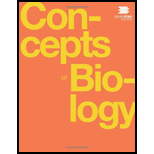
Concepts of Biology
1st Edition
ISBN: 9781938168116
Author: Samantha Fowler, Rebecca Roush, James Wise
Publisher: OpenStax College
expand_more
expand_more
format_list_bulleted
Concept explainers
Textbook Question
Chapter 16, Problem 31CTQ
Discuss why obesity is a growing epidemic.
Expert Solution & Answer
Want to see the full answer?
Check out a sample textbook solution
Students have asked these similar questions
Draw it out, don't just write it. Do the format/diagram.
please draw in what the steps are given.
Thank you!
please draw in and fill out the empty slots from image below.
thank you!
Chapter 16 Solutions
Concepts of Biology
Ch. 16 - Figure 16.2 When bacteria are destroyed by...Ch. 16 - Figure 16.7 Which of the following statements...Ch. 16 - Figure 16.9 Which of the following statements...Ch. 16 - Figure 16.10 Which of the following statements...Ch. 16 - Figure 16.14 Goiter, a disease caused by iodine...Ch. 16 - When faced with a sudden drop in environmental...Ch. 16 - How are wastes carried to the kidney for removal?...Ch. 16 - What is the cause of a fever of 38.3C(101F) ? a....Ch. 16 - Where does the majority of fat digestion take...Ch. 16 - The bile from the liver is delivered to the...
Ch. 16 - Which of the following statements is not true? a....Ch. 16 - The respiratory system_______. a. provides body...Ch. 16 - Which is the order of airflow during inhalation?...Ch. 16 - Where does the right ventricle send blood? a. the...Ch. 16 - During the systolic phase of the cardiac cycle,...Ch. 16 - How do arteries differ from veins? a. Arteries...Ch. 16 - Most of the hormones produced by the anterior...Ch. 16 - What is the function of the hormone...Ch. 16 - Which endocrine glands are associated with the...Ch. 16 - Among other bones, the axial skeleton includes...Ch. 16 - The pectoral girdle supports the_______. a. arms...Ch. 16 - Which component is responsible for initially...Ch. 16 - What kind of muscle tissue is found surrounding...Ch. 16 - Neurons contain ________, which can receive...Ch. 16 - The part of the brain that is responsible for...Ch. 16 - Which part of the nervous system directly controls...Ch. 16 - Describe how the body’s mechanisms maintain...Ch. 16 - Why is excretion important in order to achieve...Ch. 16 - What is the role of the accessory organs in...Ch. 16 - What is the role of minerals in maintaining good...Ch. 16 - Discuss why obesity is a growing epidemic.Ch. 16 - Describe the function of these terms and describe...Ch. 16 - How does the structure of alveoli maximize gas...Ch. 16 - Describe the cardiac cycle.Ch. 16 - What is a similarity and a difference between an...Ch. 16 - Describe how hormone receptors can play a role in...Ch. 16 - Many hormone systems regulate body functions...Ch. 16 - What movements occur at the hip joint and knees as...Ch. 16 - How are neurons similar to other cells? How are...Ch. 16 - What are the main functions of the spinal cord?Ch. 16 - What are the main differences between the...Ch. 16 - What are the main functions of the sensory-somatic...
Additional Science Textbook Solutions
Find more solutions based on key concepts
True or false? Some trails are considered vestigial because they existed long ago.
Biological Science (6th Edition)
1. Why is the quantum-mechanical model of the atom important for understanding chemistry?
Chemistry: Structure and Properties (2nd Edition)
What percentage of Earths land surface do glaciers presently cover? ____________
Applications and Investigations in Earth Science (9th Edition)
A variety of pea plant called Blue Persian produces a tall plant with blue seeds. A second variety of pea plant...
Genetic Analysis: An Integrated Approach (3rd Edition)
Match the following examples of mutagens. Column A Column B ___a. A mutagen that is incorporated into DNA in pl...
Microbiology: An Introduction
Distinguish between microevolution, speciation, and macroevolution.
Campbell Essential Biology (7th Edition)
Knowledge Booster
Learn more about
Need a deep-dive on the concept behind this application? Look no further. Learn more about this topic, biology and related others by exploring similar questions and additional content below.Similar questions
- There is a species of eagle, which lives in a tropical forest in Brazil. The alula pattern of its wings is determined by a single autosomal gene with four alleles that exhibit an unknown hierarchy of dominance. Genetic testing shows that individuals 1-1, 11-4, 11-7, III-1, and III-4 are each homozygous. How many possible genotypes among checkered eagles in the population?arrow_forwardwhat is this called?arrow_forwardcan you help me identify this it's based on onion rootarrow_forward
- Which evidence-based stress management techniques are most effective in reducing chronic stress and supporting college students’ academic success?arrow_forwardstudents in a science class investiged the conditions under which corn seeds would germinate most successfully. BAsed on the results which of these factors appears most important for successful corn seed germination.arrow_forwardI want to write the given physician orders in the kardex formarrow_forward
- Amino Acid Coclow TABle 3' Gly Phe Leu (G) (F) (L) 3- Val (V) Arg (R) Ser (S) Ala (A) Lys (K) CAG G Glu Asp (E) (D) Ser (S) CCCAGUCAGUCAGUCAG 0204 C U A G C Asn (N) G 4 A AGU C GU (5) AC C UGA A G5 C CUGACUGACUGACUGAC Thr (T) Met (M) lle £€ (1) U 4 G Tyr Σε (Y) U Cys (C) C A G Trp (W) 3' U C A Leu בוט His Pro (P) ££ (H) Gin (Q) Arg 흐름 (R) (L) Start Stop 8. Transcription and Translation Practice: (Video 10-1 and 10-2) A. Below is the sense strand of a DNA gene. Using the sense strand, create the antisense DNA strand and label the 5' and 3' ends. B. Use the antisense strand that you create in part A as a template to create the mRNA transcript of the gene and label the 5' and 3' ends. C. Translate the mRNA you produced in part B into the polypeptide sequence making sure to follow all the rules of translation. 5'-AGCATGACTAATAGTTGTTGAGCTGTC-3' (sense strand) 4arrow_forwardWhat is the structure and function of Eukaryotic cells, including their organelles? How are Eukaryotic cells different than Prokaryotic cells, in terms of evolution which form of the cell might have came first? How do Eukaryotic cells become malignant (cancerous)?arrow_forwardWhat are the roles of DNA and proteins inside of the cell? What are the building blocks or molecular components of the DNA and proteins? How are proteins produced within the cell? What connection is there between DNA, proteins, and the cell cycle? What is the relationship between DNA, proteins, and Cancer?arrow_forward
arrow_back_ios
SEE MORE QUESTIONS
arrow_forward_ios
Recommended textbooks for you
 Concepts of BiologyBiologyISBN:9781938168116Author:Samantha Fowler, Rebecca Roush, James WisePublisher:OpenStax CollegeLifetime Physical Fitness & WellnessHealth & NutritionISBN:9781337677509Author:HOEGERPublisher:Cengage
Concepts of BiologyBiologyISBN:9781938168116Author:Samantha Fowler, Rebecca Roush, James WisePublisher:OpenStax CollegeLifetime Physical Fitness & WellnessHealth & NutritionISBN:9781337677509Author:HOEGERPublisher:Cengage Nutrition Through The Life CycleHealth & NutritionISBN:9781337919333Author:Brown, Judith E.Publisher:Cengage Learning,
Nutrition Through The Life CycleHealth & NutritionISBN:9781337919333Author:Brown, Judith E.Publisher:Cengage Learning,

Concepts of Biology
Biology
ISBN:9781938168116
Author:Samantha Fowler, Rebecca Roush, James Wise
Publisher:OpenStax College

Lifetime Physical Fitness & Wellness
Health & Nutrition
ISBN:9781337677509
Author:HOEGER
Publisher:Cengage




Nutrition Through The Life Cycle
Health & Nutrition
ISBN:9781337919333
Author:Brown, Judith E.
Publisher:Cengage Learning,
How stress affects your body - Sharon Horesh Bergquist; Author: TED-Ed;https://www.youtube.com/watch?v=v-t1Z5-oPtU;License: Standard Youtube License